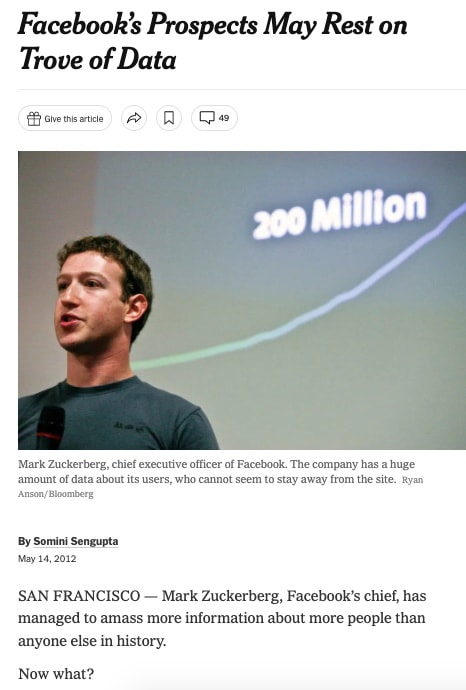The other night, I found myself playing a Sherlock Holmes-themed board game. The general set-up goes like this : the president of an arms manufacturing company is found shot to death outside of his office, and the game’s players have to work together to figure out who did it—and why.
My friends and I started by listing the possible motives for the murder:
Money: who had something to gain from the president’s death?
Love / revenge: who had a vendetta against the victim that would’ve driven them to murder?
Power / information: who wanted access to or control of the top-secret information about arms deals that the victim was carrying in his briefcase?
The game was created in 1982, but that last motivation—access to information—is just as if not more relevant today, four decades removed. And not just for London arms dealers and the detectives at 221 Baker Street investigating their possible murder. (Spoiler alert: it was that last motive that ended up unlocking the case!)
Information and data are the forces behind successful companies. Keep in mind that:
Nearly 66% of business leaders find that the greatest benefit of data and analytics at work is driving business strategy, and 49% of companies say the greatest benefit is making better decisions, per Deloitte
96% of businesses feel that analytics will become even more important to their organizations in the next three years, per Deloitte
Data-driven companies are growing at an average rate of more than 30% each year, per Forrester
“Innovative, analytically mature organizations make use of data from multiple sources: customers, vendors, regulators, and even competitors,” found a 2018 MIT Sloan Management Review report .
But you don’t need to take illegal action to get access to the data you need (so Sherlock Holmes can rest easy). Whether you collect your own data, buy it from external vendors, or do a combination of both, there’s plenty of consumer data out there that you can use to help you:
Maximize ROI
Find new customers
Convert leads
Increase engagement
Analyze trends
Prioritize new products and services
Predict sales and revenue
Improve processes
In this guide to the future of consumer data and what impact it has on businesses, we’ll go over:
Part One: How Data Capturing Has Changed in the Last 4 Years
Part Two: How Retailers Use Data to Grow Sales and Retain Customers
Part Three: What Options Retailers Have in Today’s Data Environment (And Why First-Party Data is the Future)
Part One: How Data Capturing Has Changed in the Last 4 Years
In 2017, The Economist made a bold claim: they said that “the world’s most valuable resource is no longer oil, but data.”
They supported that argument by referencing the fact that several titans of technology, among them Alphabet, Amazon, Apple, Facebook, and Microsoft, were “unstoppable,” with huge coffers, surging profits, and growing appetites for consumer data.
It’s not just reporters who were concerned about tech giants amassing treasure troves of valuable consumer data. Individuals—that is, you and me—have expressed concern, too. In a 2019 Pew poll , 81% of Americans reported feeling like they had no control over the data that companies collected on them, and 79% were very or somewhat concerned about how companies used that data.
This period of increased scrutiny on tech giants and what exactly they were doing with our information sparked a new era of data privacy laws, including:
The General Data Protection Regulation (GDPR), introduced in Europe in 2018. It enhanced protection of EU citizens’ data and forced businesses to store and process it in transparent, secure ways. (Every time you get asked to consent to cookies while browsing the web from the EU, you have the GDPR to thank.) The law is regularly enforced, like in a 2021 case that led to a €746 million fine against Amazon .
The California Privacy Rights Act (CPRA), introduced in California in 2020. The law strengthened the California Consumer Privacy Act of 2018 and moved the state’s privacy protections closer to the European standard by limiting the amount of consumer data that businesses can collect, use, and retain. Other states, including Virginia and Colorado, have followed suit, making many businesses that operate in the States proactively take steps to comply with the CPRA to ensure they can continue to operate there.
The Personal Information Protection Law (PIPL), introduced in China in 2021. It requires businesses to localize data and reduces the amount of data that international companies can export from the country, per reports .
Apple’s iOS 14 update with its App Tracking Transparency (ATT) policy, introduced worldwide in 2021. It requires apps running on the world’s one billion iPhones to provide users with information on their data collection practices and to have them opt in, not opt out, of being tracked. (In technical terms, it allows users to block the Identifier for Advertisers, or IDFA, on their unique mobile device.) It has majorly disrupted how online advertising works—we reported on how iOS 14 made CACs surge —but it also hasn’t quite worked as designed, per WIRED , as advertisers can still gather anonymous data to target users.
According to industry reporters , Google is working on their own projects that would allow advertisers to access information based on groups of users, but not to drill down into the individual consumer level. (These projects are called Federated Learning of Cohorts and FLEDGE, per the report.)
In summary, we’re in a world where governments have wisened up to the value of consumer data and are starting to more tightly regulate it. Individuals themselves are also starting to recognize that their personal data has value. (A 2019 survey found that 59% of consumers would share their buying habits with a retailer like Amazon in exchange for a 10-30% discount on their next purchase, for instance.)
But as consumers step into having more power when it comes to tracking what they do online, how can retailers keep up?
Let’s start by understanding how retailers use that information in the first place.
Part Two: How Retailers Use Data to Grow Sales and Retain Customers
The evolution of data and privacy laws isn’t about pitting individuals against retailers.
As the Harvard Business Review reports , customers actually feel good about their data being used by the companies they shop from—in certain cases.
For instance, when data is used to improve a product or service, consumers feel they’ve gotten a fair trade. Up to two-thirds of people are willing and/or eager to share data in exchange for getting benefits, and that article gives a couple of examples of what those benefits can look like:
Google’s personal assistant app tracks calendar and location data, but uses it to inform users on when they need to leave home for an appointment
Disney’s MagicBand bracelets that users can use to unlock doors and charge purchases (but in exchange, track location data)
Amazon might be the master of using personalized data in ways that customers find useful and that also drive sales and provide future sales-driving insights. Keep in mind the following examples:
On the micro scale, Amazon uses anonymized purchase data to upsell and help customers complete their purchases—like when you buy a PlayStation on Amazon and are gently asked if you’d like to add other things that people who also purchased PlayStations bought, including extra controllers or games.
On the macro scale, Amazon uses purchasing trends over time to schedule its marketing pushes for maximum impact and ROI. For instance, they might know that customers who last bought a TV in 2018 started looking for a bigger, better model in 2021—and then in 2022, start targeting people who bought TVs in 2019 with the latest TV options.
Now, Amazon even offers Amazon Personalize : a set of developer’s tools that use machine learning technology to build real-time, personalized recommendations into retailers’ sites and checkouts.
We’ll let Amazon summarize why using personalized customer data can pay off:
It allows you to create personalized user homepages with special product recommendations based on their personal shopping history. That matters because 63% of consumers , as of October 2021, are more likely to shop with brands that personalize their shopping experience.
It lets you refine product recommendations and discover products faster to give shoppers a faster process to purchase relevant items. Shopify found that 26% of people who abandoned their cart did so because the checkout was too long. Using customer data helps you streamline that process.
It makes it easier to create effective marketing communication by knowing who to target at what time and with what offers. This is especially important as we reach peak inbox and customers are less and less likely to open non-transactional emails .
It helps drive revenue by boosting upselling and cross-selling, which can do wonders for your AOV and overall revenue .
Whether you’re a massive multinational like Amazon or a small mom-and-pop retailer, you know that knowing more about your customer base helps you serve them better—and helps you stand out against the ever-growing field of competitors who are trying to do the same.
So what options are left to you in a post-alphabet-soup—aka GDPR, CPRA, PIPL, IDFA, and probably half a dozen more by the time this article gets published—world?
Part Three: What Options Retailers Have in Today’s Data Environment (And Why First-Party Data is the Future)
Think of the biggest public valuations we’ve seen in the last few years.
Facebook, as it was known then, went public at over $100 billion . Uber at around $80 billion . Neither company was valued so highly because they were providing a much-needed service, as helpful as it was to have the first truly global social media and a useful ride-sharing app.
Both were useful, as the New York Times reported the week of Facebook’s IPO, because of the treasure trove of data their users were providing them with.
This NYT article from 2012 reveals what investors saw in Facebook then (and still see in Meta now): personal user data, or the “names, photos, tastes, and desires of nearly a billion people.”
For a while—let’s say, from 2012-2020—retailers tapped into that treasure trove of data (for a fee, of course). Facebook advertising revenue kept growing, reaching into the billions and billions of dollars .
But then came a combination of unfavorable forces. First, growing competition from other platforms like TikTok, where ad dollars are being driven in droves. Then, Apple’s stricter data privacy controls, as addressed above. And then the cherry on top: the fact that the majority of social media ads reach only 5% of their target audience due to audience saturation (too many ads, sent to too generic of audience groups).
"The cost to acquire customers on digital channels like Facebook has increased while the ability to target customers has decreased," said Mitchell Olsen, an assistant marketing professor at Notre Dame, told Reuters .
So what’s a retailer to do now?
Start generating their own first-party data.
We know that customers will opt-in to providing their data as long as there’s something in it for them.
And there’s flexibility on what exactly that “something” is. Per a 2020 Genesys survey .
39% of customers want monetary compensation for their personal data
20% most value product discounts
Younger generations care about convenience, with 20% of Gen Zs saying they’d give up their data for greater convenience in using services and 18% saying the same for more responsive customer service
We’ve seen this with Clyde customers who have set up their own product registration journeys through our partnership with Registria.
Retailers who make it easy for their customers to provide their personal information after purchase are able to get much more granular customer data than third-party retailers would provide.
And they’re able to deliver extra value to those customers through the process, in the form of easier and more accessible customer service, specialized set-up instructions, recall and product update communication, and even exclusive discounts.
It’s a transparent solution that works for everyone. You get to stay honest and helpful while also securing your own treasure trove of valuable data. All while avoiding whatever the EU, California, and Apple, amongst others, next define data privacy practices to be.
Want to learn more about how to set up product registration in order to collect your own first-party data and use it to better make, sell, and service your product?
Set up time to learn more about Clyde’s partnership with registration platform Registria today.
SIGN UP FOR OUR NEWSLETTER








